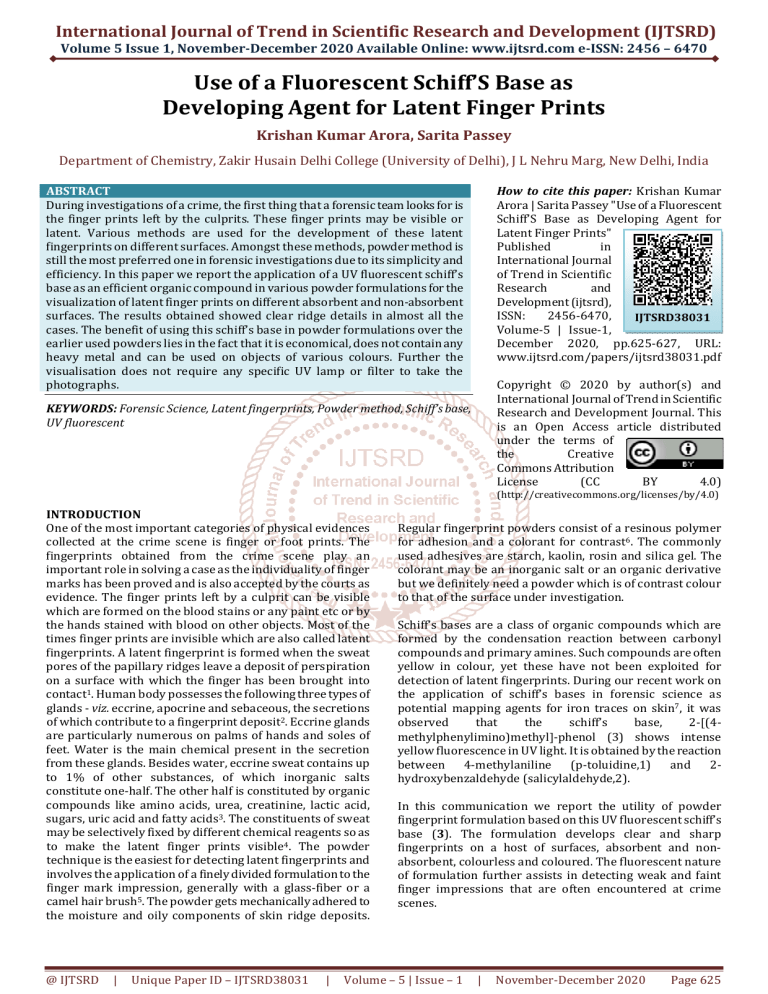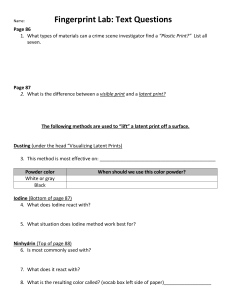
International Journal of Trend in Scientific Research and Development (IJTSRD)
Volume 5 Issue 1, November-December 2020 Available Online: www.ijtsrd.com e-ISSN: 2456 – 6470
Use of a Fluorescent Schiff’S Base as
Developing Agent for Latent Finger Prints
Krishan Kumar Arora, Sarita Passey
Department of Chemistry, Zakir Husain Delhi College (University of Delhi), J L Nehru Marg, New Delhi, India
How to cite this paper: Krishan Kumar
Arora | Sarita Passey "Use of a Fluorescent
Schiff’S Base as Developing Agent for
Latent Finger Prints"
Published
in
International Journal
of Trend in Scientific
Research
and
Development (ijtsrd),
ISSN:
2456-6470,
IJTSRD38031
Volume-5 | Issue-1,
December 2020, pp.625-627, URL:
www.ijtsrd.com/papers/ijtsrd38031.pdf
ABSTRACT
During investigations of a crime, the first thing that a forensic team looks for is
the finger prints left by the culprits. These finger prints may be visible or
latent. Various methods are used for the development of these latent
fingerprints on different surfaces. Amongst these methods, powder method is
still the most preferred one in forensic investigations due to its simplicity and
efficiency. In this paper we report the application of a UV fluorescent schiff’s
base as an efficient organic compound in various powder formulations for the
visualization of latent finger prints on different absorbent and non-absorbent
surfaces. The results obtained showed clear ridge details in almost all the
cases. The benefit of using this schiff’s base in powder formulations over the
earlier used powders lies in the fact that it is economical, does not contain any
heavy metal and can be used on objects of various colours. Further the
visualisation does not require any specific UV lamp or filter to take the
photographs.
Copyright © 2020 by author(s) and
International Journal of Trend in Scientific
Research and Development Journal. This
is an Open Access article distributed
under the terms of
the
Creative
Commons Attribution
License
(CC
BY
4.0)
KEYWORDS: Forensic Science, Latent fingerprints, Powder method, Schiff’s base,
UV fluorescent
(http://creativecommons.org/licenses/by/4.0)
INTRODUCTION
One of the most important categories of physical evidences
collected at the crime scene is finger or foot prints. The
fingerprints obtained from the crime scene play an
important role in solving a case as the individuality of finger
marks has been proved and is also accepted by the courts as
evidence. The finger prints left by a culprit can be visible
which are formed on the blood stains or any paint etc or by
the hands stained with blood on other objects. Most of the
times finger prints are invisible which are also called latent
fingerprints. A latent fingerprint is formed when the sweat
pores of the papillary ridges leave a deposit of perspiration
on a surface with which the finger has been brought into
contact1. Human body possesses the following three types of
glands - viz. eccrine, apocrine and sebaceous, the secretions
of which contribute to a fingerprint deposit2. Eccrine glands
are particularly numerous on palms of hands and soles of
feet. Water is the main chemical present in the secretion
from these glands. Besides water, eccrine sweat contains up
to 1% of other substances, of which inorganic salts
constitute one-half. The other half is constituted by organic
compounds like amino acids, urea, creatinine, lactic acid,
sugars, uric acid and fatty acids3. The constituents of sweat
may be selectively fixed by different chemical reagents so as
to make the latent finger prints visible4. The powder
technique is the easiest for detecting latent fingerprints and
involves the application of a finely divided formulation to the
finger mark impression, generally with a glass-fiber or a
camel hair brush5. The powder gets mechanically adhered to
the moisture and oily components of skin ridge deposits.
@ IJTSRD
|
Unique Paper ID – IJTSRD38031
|
Regular fingerprint powders consist of a resinous polymer
for adhesion and a colorant for contrast6. The commonly
used adhesives are starch, kaolin, rosin and silica gel. The
colorant may be an inorganic salt or an organic derivative
but we definitely need a powder which is of contrast colour
to that of the surface under investigation.
Schiff’s bases are a class of organic compounds which are
formed by the condensation reaction between carbonyl
compounds and primary amines. Such compounds are often
yellow in colour, yet these have not been exploited for
detection of latent fingerprints. During our recent work on
the application of schiff’s bases in forensic science as
potential mapping agents for iron traces on skin7, it was
observed
that
the
schiff’s
base,
2-[(4methylphenylimino)methyl]-phenol (3) shows intense
yellow fluorescence in UV light. It is obtained by the reaction
between 4-methylaniline (p-toluidine,1) and 2hydroxybenzaldehyde (salicylaldehyde,2).
In this communication we report the utility of powder
fingerprint formulation based on this UV fluorescent schiff’s
base (3). The formulation develops clear and sharp
fingerprints on a host of surfaces, absorbent and nonabsorbent, colourless and coloured. The fluorescent nature
of formulation further assists in detecting weak and faint
finger impressions that are often encountered at crime
scenes.
Volume – 5 | Issue – 1
|
November-December 2020
Page 625
International Journal of Trend in Scientific Research and Development (IJTSRD) @ www.ijtsrd.com eISSN: 2456-6470
+
(1)
(2)
(3)
Method and material
The schiff’s base (3) was prepared by the general
procedure8, described below. During the present work, using
this schiff’s base, in all 23 powder formulations have been
prepared using six different base materials viz., talc, kaolin,
boric acid, calcium carbonate, zinc stearate and silica gel.
With each of these base materials, three compositions were
prepared having the schiff’s base in 2%, 5% and 10% (w/w)
ratio. Five more formulations were preparedby mixing silica
gel with all other five base materials in the ratio of 1:1 with
5% (w/w) of schiff’s base.
Various objects have been used during present study in
order to test the applicability of these powders for
development of latent fingerprints on different type of
surfaces. The observations have been made on various nonabsorbent reflective objects viz., aluminium foil , chrome
plated spatula, stainless steel spoon and glazed tile; Non
absorbent objects viz., glass plate, wood laminate ,
transparency sheet(plastic sheet) and acrylic sheet;
Absorbent objects viz., card board, polished wood,
unlaminated paper sheets of different colours and
thermocol.
The finger marks were taken on different objects and then
allowed to dry for 10 minutes. After that the powder was
applied and then these marks were viewed under ordinary
UV lamp where yellow fluorescence was observed and these
finger prints have been photographed without the use of any
filter.
Preparation of 2-[(4-methylphenyl- imino)methyl]phenol (3) :
1.07g(0.01 mol) of 4-methylaniline (1) was dissolved in 2.5
mL of ethanol, taken in a china dish and then 1.22g (1.05 mL,
0.01 mol) of salicylaldehyde (2) was added to it with
constant mixing . A yellow solid separated within two
minutes. It was further mixed for another five minutes and
then crystallized from alcohol to give yellow needle shaped
crystals. Melting point of the compound was found to be
100-101°C (Lit.9 m.p. 100-101 °C).
Preparation of powder formulation containing schiff’s base
(5% w/w): 0.2 g of 2-[(4-methylphenylimino)methyl]phenol (3) was dissolved in 5.0 mL of acetone in a
mortar and then 3.8 g of talc was added. It was thoroughly
mixed and grinded with the help of pestle till the whole of
acetone evaporated and a fine powder was obtained. It was
further kept in air for another 10 minutes and then dried in a
vacuum desiccator for 30 minutes. The dried powder, thus
obtained, was kept in a stoppered bottle for further use. All
other formulations were similarly prepared by taking the
appropriate amounts of the schiff’s base and the base
material.
Preparation of powder formulation containing two base
materials and schiff’s base (5% w/w) : 0.2 g of 2-[(4methylphenylimino)methyl]- phenol (3) was dissolved in 5.0
mL of acetone in a mortar and then 1.9 g each of talc and
silica gel (tlc grade) were added. It was thoroughly mixed
and grinded with the help of pestle till the whole of acetone
evaporated and a fine powder was obtained. It was further
kept in air for another 10 minutes and then dried in a
vacuum desiccator for 30 minutes. The powder, thus
obtained, was kept in a stoppered bottle.
Results and discussion:
It has been observed that better results showing less
smudging and clear ridge details are obtained when
formulations with calcium carbonate , silica gel and talc are
used. Formulations containing 5% (w/w) schiff’s base
showed better results than those containing 2% (w/w),
whereas the formulations with 10% (w/w) showed no extra
benefit .Best results were obtained with a formulation
obtained by mixing silica gel and talc in 1:1 ratio with schiff’s
base in 5% (w/w) ratio. The results are evident from the
following figures. Fig.1 and Fig.2. show the results on nonabsorbing objects whereas Fig.3 shows the observations on
some absorbing objects. The results were not very
encouraging on those objects which themselves contain
some fluorescent dye e.g. white paper used for printing. The
Schiff’s base used for preparing these formulations, is costeffective and non-toxic in comparison to the other
fluorescent dyes in use. The compositions, thus prepared,
can be used to develop fingerprints on a wide spectrum of
surfaces, albeit to a varying degree. Their ability to detect
weak latent fingerprints by virtue of fluorescent property
enhances their utility in casework investigations at the crime
scene.
Fig.1 Finger prints on non-absorbing reflective objects
@ IJTSRD
|
Unique Paper ID – IJTSRD38031
|
Volume – 5 | Issue – 1
|
November-December 2020
Page 626
International Journal of Trend in Scientific Research and Development (IJTSRD) @ www.ijtsrd.com eISSN: 2456-6470
Fig.2 Finger prints on non-absorbing objects
Fig.3 Finger prints on absorbing objects
References
[1] G L Thomas, “The physics of fingerprints and their
detection”, Journal of Physics E, 11, 722-731, 1978.
[6]
R D Olsen, Scott’s Fingerprint Mechanics, Springfield:
C.C. Thomas publisher Ltd., 1978.
[2]
A M Knowles, ”Aspects of physicochemical methods
for the detection of latent Fingerprints”, Journal of
Physics E, 11, 713-721, 1978.
[7]
[3]
B Scruton, B W Robins and B H Blott, “The deposition
of fingerprint films”, Journal of Physics D, 8, 714-723,
1975.
Krishan Kumar Arora and Sarita Passey, “Schiff’s
Bases as Potential Mapping agents for Iron Traces on
Skin”, International Journal of Trend in Scientific
Research and Development, 4(6),1479-1481,2020
[8]
F G Mann and B C Saunders, Practical Organic
Chemistry, Longman Inc, New York, Fourth Edition,
pp 230,1978.
[9]
B M Saida, A A Abu-Yamin and I Saraireh,” Synthesis
of 2-{(Z)-[(4-methylphenyl)imino]methyl}phenol
Schiff’s base”, Journal of Chemical and pharmaceutical
research,5(12),1537-1541 (2013).
[4]
[5]
H C Lee and R E Gaensslen, Advances in Fingerprint
Technology (2nd edition), CRC press (1991).
G S Sodhi and J Kaur, “Powder method for detecting
latent fingerprints: A review”, Forensic Science
International, 120, 172-176, 2001.
@ IJTSRD
|
Unique Paper ID – IJTSRD38031
|
Volume – 5 | Issue – 1
|
November-December 2020
Page 627





